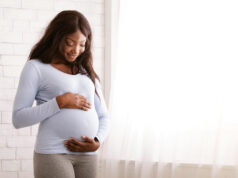Cesarean delivery or cesarean is popularly known as C-section is the delivery of babies through surgical means. This is a standard procedure recommended by doctors when natural vaginal delivery is not advisable.
This procedure involves a surgical incision to cut through the abdomen of the mother in order to give way for another incision to cut through the womb for the safe delivery of the baby/babies.
However, most women and families, due to their cultural and religious beliefs coupled with the general fear do not fancy to consent to this procedure even when the need for it is crystal clear.
What are the reasons for C-section?
Why would women and families be forced to consent to this procedure even though they would prefer to have their babies through the traditional vaginal delivery? Why would they clearly go against what they believed and sign up for the procedure?
Why would they fearfully agree to lie on the table and allow them to be cut through in order for them to carry their babies? All these questions can be answered by the doctors according to their individual challenges.
According to the World Health Organization (WHO), C-section should only be recommended when the traditional vaginal delivery seems to pose a threat to either or both the well-being of the mother and/or the baby.
This is when the traditional vaginal delivery is faced with challenges it can not overcome. These challenges include:
- When there is a reduced supply of oxygen to the baby.
- When there is prolonged labor.
- When there is transverse labor, that is when the baby starts coming out with its shoulders.
- When the baby has developmental conditions.
- When there is breech birth; this is when the baby starts coming out with its feet instead of the right position – the pope cap.
- When the baby has a head considered too big for the vagina.
- When there are early complications of pregnancy.
- If there are previous records of C-section; That is a woman who has given birth through this procedure is most likely to be delivered of her baby/babies through C-section again.
- When the mother has underlying health conditions such as; Unstable heart conditions or heart disease and High Blood Pressure (HBP).
- When the mother has active genital herpes which during vaginal delivery, the baby can easily contract it.
- When there are conditions such as placental abruption, placenta previa, and other problems that can arise with the placenta.
- When there are problems with the umbilical cord.
The above-listed reasons are the challenges that can happen to any woman leaving the woman with no choice but to subscribe to consenting to C-section.
The risks of C-section
Despite the reasons why Cesarean deliver is needed by some individuals, there are risks accompanying this procedure.
The risks include;
- Bleeding could be severe or mild.
- Blood clots: This can be prevented when the patient is encouraged to get up after the surgery and walk around to avoid this.
- Infection
- Injury to the baby on the course of the procedure.
- Delayed recovery period compared to the traditional vaginal delivery.
- Injury to other organs during the procedure.
- Breathing problems for the baby.
- Increased risks for future pregnancies.
- Endometriosis
- Many other complications of abdominal surgery including; hernia.
Although, there is hope, with the growth and development in the world of technology and in the field of medicine, that in the nearest future cesarean delivery and other procedures would pose fewer risks for the patient (who is to go through the procedure).
Follow up is necessary for the mother after a cesarean section. The mother remains on an IV right after the procedure. This gives room for painkillers to be administered in accorded adjusted levels to ease the pain while the anesthesia to wear off eventually. Here, both the newborn baby and mother will remain in the hospital for a couple of days.
Of course, a woman who is hale and hearty after being delivered of a bouncing baby is expected to breastfeed her baby, but in the case of a cesarean section whereby a specific position whether sitting standing or lying can cause additional pain to the woman. The breastfeeding position is no different.
It is a nurse or doctor that is to educate the woman on the best breastfeeding position that will be convenient for both the newborn baby and the mother, and this position should not cause more pain to the incision site from the cesarean section.
The doctor normally gives the patient home care recommendations for speed up the recovery of the patient and also to prevent possible conditions such as postpartum depression. Generally, the mother is expected to:
- To make things easy
- To rest adequately, especially for the first couple of weeks.
- To use the correct posture for the supporting of the abdomen
- To drink plenty of fluids, water, milk, and fruit juice inclusive in order to restore those lost on the course of the surgery.
- To avoid sex for about four weeks to six weeks
- To religiously take pain medications as prescribed.
- To seek help if symptoms of postpartum depression begin to show, the symptoms may include overwhelming fatigue or profound mood swings.
Endometriosis
Naturally, in a woman’s womb, there are tissues present inside to womb to support the growth of the zygote or a baby. It is that which sheds every month so women can have their periods. Because it supports pregnancy, it is highly vital for fertility.
It is normal to have this Endometrial tissue grow inside the womb, but it is a health condition that is characterized by pain when this Endometrial tissue starts growing outside the womb.
This health condition is called Endometriosis. Endometriosis, amongst the above listed, is one of the risks of C-section, and that is our main focus here.
What is endometriosis?
Endometriosis is a disorder whereby tissue linings that are typically inside the womb grows outside the womb. These tissues are called endometrial tissues.
Although endometriosis seldom spread beyond the tissue linings of the pelvic region, it is most common to occur in ovaries, fallopian tubes, and the linings of the pelvis. Talk about “common,” this disorder is quite common in women.
Types of endometriosis
Endometriosis is of two types, namely;
- Primary endometriosis: is known to not have an exact known cause.
- Secondary endometriosis or iatrogenic, endometriosis. Secondary endometriosis is known to have an exact known cause. Endometriosis occurring after a cesarean section is a form of secondary endometriosis.
How secondary endometriosis that occurs after C-section can be diagnosed
A doctor who is a specialist in the field of pathology can take a sample of the tissues and examine them under a microscope. If the cells from the tissue are similar to Endometrial tissue, it is therefore proven to be endometriosis. This is known as the most reliable way of diagnosing endometriosis.
Step by step, doctors do not just start collecting samples and start examining them because they can; that can waste a lot of time as a woman with symptoms similar to endometriosis may not be suffering from endometriosis.
First, Doctors usually start off by canceling out all other possible causes of the mass growing in your stomach through imaging studies. Tests are being conducted in order to rightly diagnose the condition.
Examples of these tests include;
- MRI: This test is often found by doctors to have results more sensitive to endometrial tissue.
- Ultrasound: Ultrasound has helped doctors in many ways. In this case, it helps the doctor know if the tumor is solid or not.
- CT scan: This scan shows unique streaks in the tissue samples that may resemble endometrium.
Although These imaging studies can be used to get so close to the diagnosis of the condition – endometriosis, the precise way to actually know is to test the sample tissues to check if they are similar to endometrial cells.
How to look out for endometriosis after C-section
The patient is encouraged to talk to the doctor if she experiences pain around and on the scar tissue after the cesarean section.
Although there may be several potential causes behind this pain. If this pain grows worse when during the period of menstruation, this could be a clear indication that endometriosis is the cause of the pain.
If the symptoms are severe with unbearable pain, it is advised that the patient discusses the treatment options with the doctor.
This condition is known to affect the fertility of some women. But this is common in the case of primary endometriosis.
It frequent that once a woman goes through a cesarean section, the likelihood that she will go through another one again when she is about to have another baby is increased.
The patient is encouraged to talk to the doctor and to create a plan adequate enough to reduce the risk of spreading tissues when she will need to go through cesarean delivery again.
Endometriosis: how can this occur after a C-section?
Endometriosis occurring after a C-section is very rare, and it is even more unusual for a woman that has primary endometriosis to be diagnosed with secondary endometriosis later. Even though this is rare, it is very much possible.
Endometriosis can occur after a cesarean section when the endometrial tissue starts growing in the area of the incision from the procedure. Secondary endometriosis is a very rare condition; therefore, doctors sometimes misdiagnose the condition for something else after pregnancy.
At times, Endometrial cells transport themselves from the inside of the womb to incision made by any surgery affecting the womb of the woman, after an operation. These cells will start growing and multiplying, which causes endometriosis symptoms.
Surgeries such as cesarean delivery and a hysterectomy (the total removal of the womb by surgical means).
Symptoms of endometriosis
The symptoms of endometriosis may vary across individuals, ranging from mild to severe. One of the symptoms of endometriosis includes pain, although this severity of this pain can not be used to determine the severity of the condition.
The symptoms include;
- Lump or tumor growth: The most common and fundamental symptom of endometriosis after a cesarean section is the growth of a lump or tumor on the scar from the surgery.
- Heavy and painful periods: This lump varies in size, and it is normally painful; this is due to the fact that the area of endometrial tissue may start bleeding. This is due to the fact that endometrial tissue is normally meant to shed itself and bleed with the female’s menstrual cycle. Some women may notice that their sit of incision bleeds more likely around the time the period comes. But not every woman notice this bleeding relating to their cycles.
- Pain between periods: This is because the bleeding can cause irritation and inflammation to the abdominal organs, and the body immunologically tries to get rid of the tumor or lump.
Note: Some women suffering from endometriosis while pregnant reportedly confirmed that their respective symptoms got better temporarily, unlike before pregnancy.
This is because the level of progesterone needed by the body during pregnancy is secreted on an increased level during pregnancy.
However, after a Cesarean section, the patient stands a slightly higher chance of developing endometriosis.
Treatment for endometriosis after C-section
Fortunately, endometriosis is a condition that can be treated. As explained above, the severity of the pain experienced can not be used to determine whether the condition is mild or severe, but the treatment is normally dependent on the severity of the symptoms.
Best explained; If the discomfort experienced is mild or the area affected by endometriosis is little, then the patient may not want more advanced treatments.
Here, the patient can simply take a pain killer which is easily accessible over-the-counter. Ibuprofen can be used to relieve pains when the pains throbbing from the affected area starts bothering the patient.
Usually, primary endometriosis can be treated with medications such as birth control pills, which can be used to control the hormones that cause this bleeding. That’s all for the primary endometriosis, but unfortunately for secondary endometriosis, medications do not normally work on it.
Surgery is recommended at this level. Here, a surgeon removes the affected area along with little portion around the affected area to be sure that the endometrial cells are all gone. Endometriosis after the cesarean section is quite rare, and that is why there is not much information about the quantity of skin being removed during surgery.
This surgical approach can be discussed with you for you to make your decisions which you consider best and safe for your well-being. After the surgery, there are fewer chances the endometriosis reoccurring again. This recurrence rate of endometriosis after surgery is as low as 4.3 percent which can be relatively less or relatively more
Fairly, the patient has the right not to choose the surgery, which will be some years in the nearest future. Gladly, the discomfort from the endometriosis disappears typically after menopause.
This is so because, at that stage, the body doesn’t make enough estrogen, which triggers bleeding and pain. Needless to say, women do not usually have endometriosis after menopause.
Summary
C-section is a procedure that serves as a safer procedure when the traditional vaginal delivery poses a threat to the health and well-being of both or either of the baby and the mother. This procedure has accompanying risks in which endometriosis is included.
Endometriosis is a medical condition whereby Endometrial tissue that was normally inside the uterus starts growing outside the uterus. This condition is quite painful, with about a handful of other symptoms.
There is quite a high chance of developing endometriosis after this procedure. The pain from endometriosis is to be managed with painkillers until the patient opts out for surgery that will remove the growth and stop the pain.
Have you had a C-section before? What complications did you experience? Are there tips or suggestions you’d like to share with us? Kindly use the comment section below.












